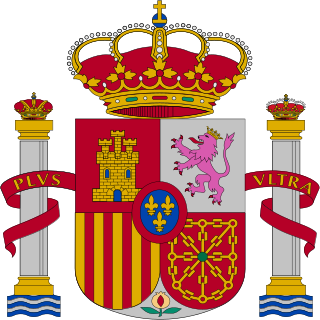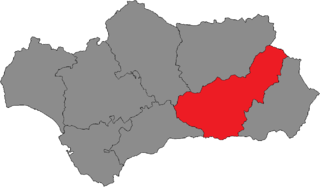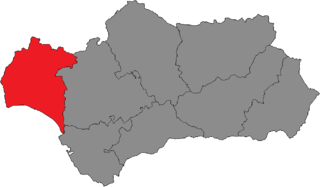
The autonomous communities are the first-level administrative divisions of Spain, created in accordance with the Spanish Constitution of 1978, with the aim of guaranteeing limited autonomy to the nationalities and regions that make up Spain.

Spain is a diverse country integrated by contrasting entities with varying economic and social structures, languages, and historical, political and cultural traditions. The Spanish constitution responds ambiguously to the claims of historic nationalities while proclaiming a common and indivisible homeland of all Spaniards.

Andalusian nationalism is the nationalism that asserts that Andalusians are a nation and promotes the cultural unity of Andalusians. In the past it was considered to be represented primarily by the Andalusian Party, but the party disbanded in 2015. In 2021, the left-wing Andalusian nationalist party Adelante Andalucía was formed, obtaining representation in the 2022 regional election.
A referendum on the reform of the Catalan Statute of Autonomy was held in Catalonia on Sunday, 18 June 2006. Voters were asked whether they ratified a statutory amendment which effectively approved a new Statute of Autonomy of Catalonia. The draft Statute had been submitted to the consideration of the Spanish Cortes Generales earlier in the year, where it had been approved in both the Congress of Deputies on 30 March and in the Spanish Senate on 10 May.

The Statute of Autonomy of Andalusia is a law hierarchically located under the 1978 Constitution of Spain, and over any legislation passed by the Andalusian Autonomous Government. During the Spanish transition to democracy, Andalusia was the one region of Spain to take its path to autonomy under what was called the "vía rápida" allowed for by Article 151 of the 1978 Constitution. That article was set out for regions like Andalusia that had been prevented by the outbreak of the Spanish Civil War from adopting a statute of autonomy during the period of the Second Spanish Republic. Following this procedure, Andalusia was constituted as an autonomous community February 28, 1980. The regional holiday of the Andalusia Day commemorates that date. The statute was approved the following year by the Spanish national government.

The 1982 Andalusian regional election was held on Sunday, 23 May 1982, to elect the 1st Parliament of the autonomous community of Andalusia. All 109 seats in the Parliament were up for election.

A referendum on the approval of the Basque Statute of Autonomy was held in the Basque Country on Thursday, 25 October 1979. Voters were asked whether they ratified a proposed Statute of Autonomy of the Basque Country bill organizing the historical territories of Álava, Biscay and Gipuzkoa into an autonomous community of Spain. The final draft of the bill had been approved by the Basque parliamentary assembly on 29 December 1978, but it required ratification through a binding referendum and its subsequent approval by the Spanish Cortes Generales, as established by Article 151 of the Spanish Constitution of 1978.
A referendum on the approval of the Catalan Statute of Autonomy was held in Catalonia on Thursday, 25 October 1979. Voters were asked whether they ratified a proposed Statute of Autonomy of Catalonia bill organizing the provinces of Barcelona, Gerona, Lérida and Tarragona into an autonomous community of Spain. The final draft of the bill had been approved by the Catalan Assembly of Parliamentarians on 29 December 1978, and by the Congress of Deputies on 13 August 1979, but it required ratification through a binding referendum and its subsequent approval by the Spanish Cortes Generales, as established by Article 151 of the Spanish Constitution of 1978. The referendum was held simultaneously with a similar vote in the Basque Country.

Seville is one of the eight constituencies represented in the Parliament of Andalusia, the regional legislature of the Autonomous Community of Andalusia. The constituency currently elects 18 deputies. Its boundaries correspond to those of the Spanish province of Seville. The electoral system uses the D'Hondt method and a closed-list proportional representation, with a minimum threshold of three percent.

Almería is one of the eight constituencies represented in the Parliament of Andalusia, the regional legislature of the Autonomous Community of Andalusia. The constituency currently elects 12 deputies. Its boundaries correspond to those of the Spanish province of Almería. The electoral system uses the D'Hondt method and a closed-list proportional representation, with a minimum threshold of three percent.

Cádiz is one of the eight constituencies represented in the Parliament of Andalusia, the regional legislature of the Autonomous Community of Andalusia. The constituency currently elects 15 deputies. Its boundaries correspond to those of the Spanish province of Cádiz. The electoral system uses the D'Hondt method and a closed-list proportional representation, with a minimum threshold of three percent.

Córdoba is one of the eight constituencies represented in the Parliament of Andalusia, the regional legislature of the Autonomous Community of Andalusia. The constituency currently elects 12 deputies. Its boundaries correspond to those of the Spanish province of Córdoba. The electoral system uses the D'Hondt method and a closed-list proportional representation, with a minimum threshold of three percent.

Granada is one of the eight constituencies represented in the Parliament of Andalusia, the regional legislature of the Autonomous Community of Andalusia. The constituency currently elects 13 deputies. Its boundaries correspond to those of the Spanish province of Granada. The electoral system uses the D'Hondt method and a closed-list proportional representation, with a minimum threshold of three percent.

Huelva is one of the eight constituencies represented in the Parliament of Andalusia, the regional legislature of the Autonomous Community of Andalusia. The constituency currently elects 11 deputies. Its boundaries correspond to those of the Spanish province of Huelva. The electoral system uses the D'Hondt method and a closed-list proportional representation, with a minimum threshold of three percent.

Jaén is one of the eight constituencies represented in the Parliament of Andalusia, the regional legislature of the Autonomous Community of Andalusia. The constituency currently elects 11 deputies. Its boundaries correspond to those of the Spanish province of Jaén. The electoral system uses the D'Hondt method and a closed-list proportional representation, with a minimum threshold of three percent.

Málaga is one of the eight constituencies represented in the Parliament of Andalusia, the regional legislature of the Autonomous Community of Andalusia. The constituency currently elects 17 deputies. Its boundaries correspond to those of the Spanish province of Málaga. The electoral system uses the D'Hondt method and a closed-list proportional representation, with a minimum threshold of three percent.
A referendum on the approval of the Galician Statute of Autonomy was held in Galicia on Sunday, 21 December 1980. Voters were asked whether they ratified a proposed Statute of Autonomy of Galicia bill organizing the provinces of La Coruña, Lugo, Orense and Pontevedra into an autonomous community of Spain. The final draft of the bill had been approved following an inter-party agreement on 26 September 1980, but it required ratification through a binding referendum and its subsequent approval by the Spanish Cortes Generales, as established under Article 151 of the Spanish Constitution of 1978.
A referendum on the initiative of the Andalusian autonomy process was held in Andalusia on Thursday, 28 February 1980. Voters were asked whether they ratified a proposed initiative for the provinces of Almería, Cádiz, Córdoba, Granada, Huelva, Jaén, Málaga and Seville to organize themselves into an autonomous community of Spain throughout the legal procedure outlined in Article 151 of the Spanish Constitution of 1978.
A referendum on the approval of the Andalusian Statute of Autonomy was held in Andalusia on Tuesday, 20 October 1981. Voters were asked whether they ratified a proposed Statute of Autonomy of Andalusia bill organizing the provinces of Almería, Cádiz, Córdoba, Granada, Huelva, Jaén, Málaga and Seville into an autonomous community of Spain. The final draft of the bill had been approved by the Andalusian Assembly of Parliamentarians on 1 March 1981, but it required ratification through a binding referendum and its subsequent approval by the Spanish Cortes Generales, as established under Article 151 of the Spanish Constitution of 1978. The referendum was held simultaneously with a regional election in Galicia.

In Spain, a president of an Autonomous Community serves as the chief executive officer in each of the seventeen Autonomous communities and in the two Autonomous cities, where they receive the name of "Mayor-Presidents". As such, regional presidents are responsible for implementing regional laws and overseeing the operation of the state executive branch. As regional leaders, governors advance and pursue new and revised policies and programs using a variety of tools, among them executive laws, executive budgets, and legislative proposals.














